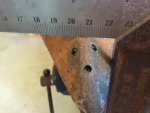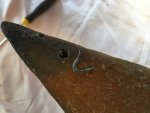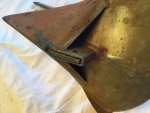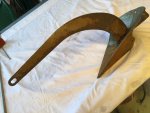Neeves
Well-known member
Some notes
I am arranging for the Spade anchor of some friends to be regalvanised. The anchor is an S60, galvanised steel, but has a simple plate shank - not the complex hollow fabricated shanks of the S80 and larger models.
I had to remove the lead.
I used a Japanese stove, used for Korean BBQ. They use those disposable gas cylinders. You could use any camping stove (Camping Gas comes to mind) but the Japanese stove is 'flat' and you can place the fluke directly on the 'hob' plate to heat the fluke (as you would a saucepan). Being flat it is more stable - I recall Camping Gaz stoves tended to be 'tall'. I arranged the anchor to sit 'toe up' so that the lead could flow by gravity out the rear of the ballast chamber. I cut up a tin can to make a chute to catch the molten lead so that it dropped onto a flat peice of metal (Like lava from a Spanish volcano). I supplemented the camping stove with a blow torch once the lead started to flow. Lead melts at about 375 deg C - it does not take long to get the lead melting and I used, roughly, one cylinder of gas, and some from the blow torch. When the lead was flowing, so the ballast chamber was upto heat - I could still tweak the 'lie' of the anchor using the shank and the leather gloves.
It was relatively straight forward.
The one surprise - I started by melting lead in the toe - it melted quickly enough and flowed out as a vertical fountain from the toe - about 4cm high jet of molten lead. I thought that there must be a hole in the weld but it appears there are three holes in the toe - to ensure that the toe is completely filled when they pour molten lead in? (no air gaps).
Of the 10kg anchor 3.6kg is lead - which I found to be quite extraordinary (not a criticism - just an observation).
The anchor will be galvanised in the next fortnight by Armorgalv (an update on the Sherardizing process). The Armorgalv process incorporates grit blasting as part of the process, acid is not used - so they are quite happy to accept painted product.
Once galvanised I'll remelt the lead, all of which I collected, and pour back into the ballast chamber. I'm not sure how the molten lead will 'work' with the holes in the toe when I refill (will the lead simple flow out as fast as I pour out in......)
When working I wear a cotton boiler suit, heavy duty leather gloves, goggles and a wool hat (don't I look daft with a woollen hat when its 25 degrees and have a stove and blow torch blazing away?). The stove sits on a 2cm marble slab on top of a work bench. I ensure I have no interruptions. I have a large extractor fan over the work bench (apparently lead his decidedly unhealthy - though when you get to that age of maturity - does it matter!).
If the anchor were a larger model, say 20kg, it might be more difficult, or take longer, to get the lead upto temperature and would be more physically demanding to lug about.
If you have the space and 'privacy' its not a difficult task.
Take care, stay safe
Jonathan
I am arranging for the Spade anchor of some friends to be regalvanised. The anchor is an S60, galvanised steel, but has a simple plate shank - not the complex hollow fabricated shanks of the S80 and larger models.
I had to remove the lead.
I used a Japanese stove, used for Korean BBQ. They use those disposable gas cylinders. You could use any camping stove (Camping Gas comes to mind) but the Japanese stove is 'flat' and you can place the fluke directly on the 'hob' plate to heat the fluke (as you would a saucepan). Being flat it is more stable - I recall Camping Gaz stoves tended to be 'tall'. I arranged the anchor to sit 'toe up' so that the lead could flow by gravity out the rear of the ballast chamber. I cut up a tin can to make a chute to catch the molten lead so that it dropped onto a flat peice of metal (Like lava from a Spanish volcano). I supplemented the camping stove with a blow torch once the lead started to flow. Lead melts at about 375 deg C - it does not take long to get the lead melting and I used, roughly, one cylinder of gas, and some from the blow torch. When the lead was flowing, so the ballast chamber was upto heat - I could still tweak the 'lie' of the anchor using the shank and the leather gloves.
It was relatively straight forward.
The one surprise - I started by melting lead in the toe - it melted quickly enough and flowed out as a vertical fountain from the toe - about 4cm high jet of molten lead. I thought that there must be a hole in the weld but it appears there are three holes in the toe - to ensure that the toe is completely filled when they pour molten lead in? (no air gaps).
Of the 10kg anchor 3.6kg is lead - which I found to be quite extraordinary (not a criticism - just an observation).
The anchor will be galvanised in the next fortnight by Armorgalv (an update on the Sherardizing process). The Armorgalv process incorporates grit blasting as part of the process, acid is not used - so they are quite happy to accept painted product.
Once galvanised I'll remelt the lead, all of which I collected, and pour back into the ballast chamber. I'm not sure how the molten lead will 'work' with the holes in the toe when I refill (will the lead simple flow out as fast as I pour out in......)
When working I wear a cotton boiler suit, heavy duty leather gloves, goggles and a wool hat (don't I look daft with a woollen hat when its 25 degrees and have a stove and blow torch blazing away?). The stove sits on a 2cm marble slab on top of a work bench. I ensure I have no interruptions. I have a large extractor fan over the work bench (apparently lead his decidedly unhealthy - though when you get to that age of maturity - does it matter!).
If the anchor were a larger model, say 20kg, it might be more difficult, or take longer, to get the lead upto temperature and would be more physically demanding to lug about.
If you have the space and 'privacy' its not a difficult task.
Take care, stay safe
Jonathan




